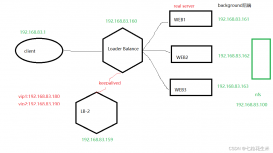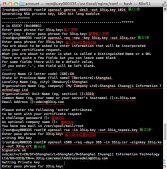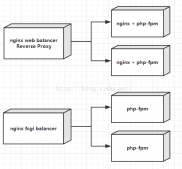nginx location介绍
Nginx 中的 Location 指令 是NginxHttpCoreModule中重要指令。Location 指令,是用来为匹配的 URI 进行配置,URI 即语法中的”/uri/”,可以是字符串或正则表达式。但如果要使用正则表达式,则必须指定前缀。
nginx location语法
基本语法:location [=|~|~*|^~] /uri/ { … }
= 严格匹配。如果这个查询匹配,那么将停止搜索并立即处理此请求。
~ 为区分大小写匹配(可用正则表达式)
~* 为不区分大小写匹配(可用正则表达式)
!~和!~*分别为区分大小写不匹配及不区分大小写不匹配
^~ 如果把这个前缀用于一个常规字符串,那么告诉nginx 如果路径匹配那么不测试正则表达式。
nginx location应用实例
- location = / {
- # 只匹配 / 查询。
- }
- location / {
- # 匹配任何查询,因为所有请求都已 / 开头。但是正则表达式规则和长的块规则将被优先和查询匹配。
- }
- location ^~ /images/ {
- # 匹配任何已 /images/ 开头的任何查询并且停止搜索。任何正则表达式将不会被测试。
- }
- location ~* \.(gif|jpg|jpeg)$ {
- # 匹配任何已 gif、jpg 或 jpeg 结尾的请求。
- }
- location ~* \.(gif|jpg|swf)$ {
- valid_referers none blocked start.igrow.cn sta.igrow.cn;
- if ($invalid_referer) {
- #防盗链
- rewrite ^/ http://$host/logo.png;
- }
- }
- location ~* \.(js|css|jpg|jpeg|gif|png|swf)$ {
- if (-f $request_filename) {
- #根据文件类型设置过期时间
- expires 1h;
- break;
- }
- }
- location ~* \.(txt|doc)${
- #禁止访问某个目录
- root /data/www/wwwroot/linuxtone/test;
- deny all;
- }
以下是补充:
Nginx Location基本语法
location
syntax: location [=|~|~*|^~] /uri/ { … }
语法:location [=|~|~*|^~] /uri/ { … }
default: no
默认:否
context: server
上下文:server
This directive allows different configurations depending on the URI. It can be configured using both conventional strings and regular expressions. To use regular expressions, you must use the prefix ~* for case insensitive match and ~ for case sensitive match.
这个指令随URL不同而接受不同的结构。你可以配置使用常规字符串和正则表达式。如果使用正则表达式,你必须使用 ~* 前缀选择不区分大小写的匹配或者 ~ 选择区分大小写的匹配。
To determine which location directive matches a particular query, the conventional strings are checked first. Conventional strings match the beginning portion of the query and are case-sensitive - the most specific match will be used (see below on how nginx determines this). Afterwards, regular expressions are checked in the order defined in the configuration file. The first regular expression to match the query will stop the search. If no regular expression matches are found, the result from the convention string search is used.
确定 哪个location 指令匹配一个特定指令,常规字符串第一个测试。常规字符串匹配请求的开始部分并且区分大小写,最明确的匹配将会被使用(查看下文明白 nginx 怎么确定它)。然后正则表达式按照配置文件里的顺序测试。找到第一个比配的正则表达式将停止搜索。如果没有找到匹配的正则表达式,使用常规字符串的结果。
There are two ways to modify this behavior. The first is to use the prefix “=”, which matches an exact query only. If the query matches, then searching stops and the request is handled immediately. For example, if the request “/” occurs frequently, then using “location = /” will expedite the processing of this request.
有两个方法修改这个行为。第一个方法是使用 “=”前缀,将只执行严格匹配。如果这个查询匹配,那么将停止搜索并立即处理这个请求。例子:如果经常发生”/”请求,那么使用 “location = /” 将加速处理这个请求。
The second is to use the prefix ^~. This prefix is used with a conventional string and tells nginx to not check regular expressions if the path provided is a match. For instance, “location ^~ /images/” would halt searching if the query begins with /images/ - all regular expression directives would not be checked.
第二个是使用 ^~ 前缀。如果把这个前缀用于一个常规字符串那么告诉nginx 如果路径匹配那么不测试正则表达式。
Furthermore it is important to know that NGINX does the comparison not URL encoded, so if you have a URL like “/images/%20/test” then use “/images/ /test” to determine the location.
而且它重要在于 NGINX 做比较没有 URL 编码,所以如果你有一个 URL 链接'/images/%20/test' , 那么使用 “images/ /test” 限定location。
To summarize, the order in which directives are checked is as follows:
总结,指令按下列顺序被接受:
1. Directives with the = prefix that match the query exactly. If found, searching stops.
1. = 前缀的指令严格匹配这个查询。如果找到,停止搜索。
2. All remaining directives with conventional strings, longest match first. If this match used the ^~ prefix, searching stops.
2. 剩下的常规字符串,长的在前。如果这个匹配使用 ^~ 前缀,搜索停止。
3. Regular expressions, in order of definition in the configuration file.
3. 正则表达式,按配置文件里的顺序。
4. If #3 yielded a match, that result is used. Else the match from #2 is used.
4. 如果第三步产生匹配,则使用这个结果。否则使用第二步的匹配结果。
Example:
例子:
location = / {
# matches the query / only.
# 只匹配 / 查询。
[ configuration A ]
}
location / {
# matches any query, since all queries begin with /, but regular
# expressions and any longer conventional blocks will be
# matched first.
# 匹配任何查询,因为所有请求都已 / 开头。但是正则表达式规则和长的块规则将被优先和查询匹配。
[ configuration B ]
}
location ^~ /images/ {
# matches any query beginning with /images/ and halts searching,
# so regular expressions will not be checked.
# 匹配任何已 /images/ 开头的任何查询并且停止搜索。任何正则表达式将不会被测试。
[ configuration C ]
}
location ~* ".(gif|jpg|jpeg)$ {
# matches any request ending in gif, jpg, or jpeg. However, all
# requests to the /images/ directory will be handled by
# Configuration C.
# 匹配任何已 gif、jpg 或 jpeg 结尾的请求。然而所有 /images/ 目录的请求将使用 Configuration C。
[ configuration D ]
}
Example requests:
例子请求:
*
/ -> configuration A
*
/documents/document.html -> configuration B
*
/images/1.gif -> configuration C
*
/documents/1.jpg -> configuration D
Note that you could define these 4 configurations in any order and the results would remain the same.
注意:按任意顺序定义这4个配置结果将仍然一样。
Nginx Location 语法,与简单配置
一、介绍Nginx是俄罗斯人编写的十分轻量级的HTTP服务器,Nginx,它的发音为“engine X”, 是一个高性能的HTTP和反向代理服务器,同时也是一个IMAP/POP3/SMTP 代理服务器.
二、Location语法语法:location [=|~|~*|^~] /uri/ { … }
注:
1、~ 为区分大小写匹配
2、~* 为不区分大小写匹配
3、!~和!~*分别为区分大小写不匹配及不区分大小写不匹配
示例一:
location / { }
匹配任何查询,因为所有请求都以 / 开头。但是正则表达式规则将被优先和查询匹配。
示例二:
location =/ {}
仅仅匹配/
示例三:
location ~* \.(gif|jpg|jpeg)$ {
rewrite \.(gif|jpg)$ /logo.png;
}
注:不区分大小写匹配任何以gif,jpg,jpeg结尾的文件
三、ReWrite语法
last - 基本上都用这个Flag。
break - 中止Rewirte,不在继续匹配
redirect - 返回临时重定向的HTTP状态302
permanent - 返回永久重定向的HTTP状态301
1、下面是可以用来判断的表达式:
-f和!-f用来判断是否存在文件
-d和!-d用来判断是否存在目录
-e和!-e用来判断是否存在文件或目录
-x和!-x用来判断文件是否可执行
2、下面是可以用作判断的全局变量
例:http://localhost:88/test1/test2/test.php
$host:localhost
$server_port:88
$request_uri:http://localhost:88/test1/test2/test.php
$document_uri:/test1/test2/test.php
$document_root:D:\nginx/html
$request_filename:D:\nginx/html/test1/test2/test.php
四、Redirect语法
server {
listen 80;
server_name start.igrow.cn;
index index.html index.php;
root html;
if ($http_host !~ "^star\.igrow\.cn$" {
rewrite ^(.*) http://star.igrow.cn$1 redirect;
}
}
五、防盗链
location ~* \.(gif|jpg|swf)$ {
valid_referers none blocked start.igrow.cn sta.igrow.cn;
if ($invalid_referer) {
rewrite ^/ http://$host/logo.png;
}
}
六、根据文件类型设置过期时间
location ~* \.(js|css|jpg|jpeg|gif|png|swf)$ {
if (-f $request_filename) {
expires 1h;
break;
}
}
七、禁止访问某个目录
location ~* \.(txt|doc)${
root /data/www/wwwroot/linuxtone/test;
deny all;
}
















